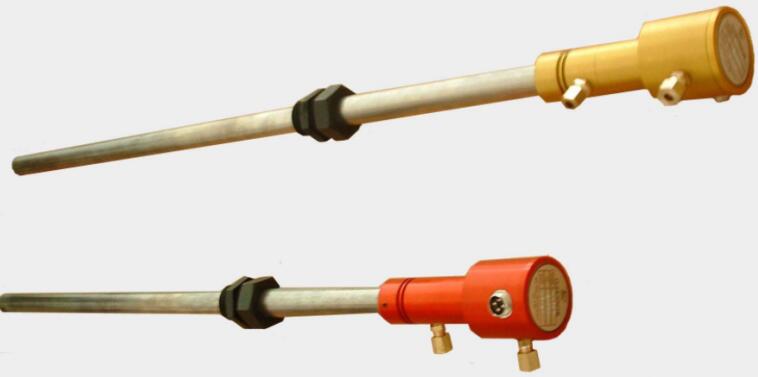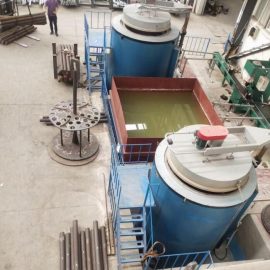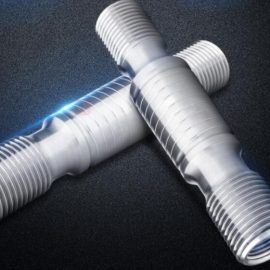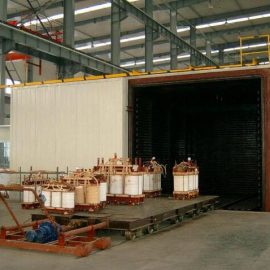Oxygen Probe In Gas Cementation Furnace
Working Principle, Selection And Installation And Maintenance Method Of Oxygen Probe In Gas Cementation Furnace
The research and application of precise control of gas carburization with oxygen probes has a history of 20 years. With the continuous advancement of oxygen probe manufacturing technology, in recent years, more and more oxygen probes are used as carbon sensors for the control of carbon potential in cementation furnaces. As the key sensor component of carbon potential control technology, oxygen probe has fast response speed (response time less than or equal to 1ms) and high carbon potential control accuracy compared with other types of carbon sensors, such as dew point meter, CO2 infrared meter and resistance probe. (±0.05%C), good accuracy, direct measurement, no need to take gas and many other advantages, so it is widely used in heat treatment cementation , carbonitriding, bright quenching, bright annealing and bright normalizing and other processes, as well as protection Endothermic, drip-injection, nitrogen-based, and direct-generated atmospheres are suitable for various furnace types such as multi-purpose box furnaces, continuous gas cementation furnaces, and don-type gas cementation furnaces.
The application of oxygen probes in heat treatment production is becoming more and more extensive, but the price of oxygen probes is relatively expensive, ranging from a few thousand yuan domestically to an imported tens of thousands of yuan. In China, there are Tianjin Tianming, Wuhan Huamin, Beijing Huijietong, Beijing Peit Yongchang Company, etc. In foreign countries, there are American Marathon, American SSI, British Continental—EUTRHERM, and other Johnson, Bosch and so on. Practice has proved that through the reasonable selection, accurate installation, correct use of the oxygen probe, and timely maintenance, not only the service life of the oxygen probe can be greatly improved, but also the precise control of the carbon potential in the heat treatment furnace is very important, so as to ensure the product Achieving a 100% pass rate. To this end, measures can be taken mainly from the following aspects.

1. The working principle of oxygen probe
The working principle of zirconia oxygen probe: Zirconia tube is a stable zirconia ceramic sintered body formed by sintering zirconia material with a certain amount of yttrium oxide or calcium oxide at high temperature. Since its cubic lattice contains oxygen ion holes, it is a good oxygen ion conductor at high temperatures. Because of this characteristic, at a certain high temperature, when the oxygen content on both sides of the zirconium tube is different, it is a typical oxygen concentration difference battery. In this battery, air is the reference gas, and it and the flue gas are located inside and outside. electrode.
2. The selection of oxygen probe
First of all, you should choose products from regular manufacturers, choose appropriate oxygen probe models and specifications, and have product test reports or certificates: Second, you should consider the following issues.
2.1. Select the effective length of the oxygen probe according to the thickness of the furnace wall, generally 500mm, 600mm, 750mm, 900mm, 1000mm and 1200mm, etc. The outer diameter of the commonly used oxygen probes are 20mm, 22mm, and 25mm.
2.2 The matching of oxygen probe and carbon controller should be considered. Due to the difference in the manufacturing process and electrode material of the oxygen probe, the oxygen potential millivolt output of different oxygen probes may be different. When the oxygen probe is replaced, the relevant carbon controller needs to be re-calibrated to adapt to the new oxygen probe output. Of course, most oxygen probes are compatible and can be matched with any type of carbon controller.
2.3 Since the oxygen probe is very sensitive to temperature, in order to avoid the influence of the temperature difference between the oxygen probe and the thermocouple on the carbon potential measurement due to the different installation positions, an oxygen probe with a thermocouple should be selected as much as possible. Practice has proved that it is important to use an oxygen probe with a thermocouple in order to obtain the actual carbon potential value. Oxygen probes with thermocouples have an integral thermocouple, preferably the S-type because the S-type thermocouple is more durable.
2..4 According to the temperature selection, in general, choose an oxygen probe with a temperature of 800-1000 degrees. In order to meet the needs of high temperature and rapid carburization, a long-life oxygen probe with a temperature greater than 1000 degrees can be selected.
2.5 Select an oxygen probe with a more sensitive response and a small thermal internal resistance (less than 0.5 kΩ), which has a longer service life than an oxygen probe with a high internal resistance.
2.6 Choose an oxygen probe that can replace damaged parts (such as: zirconia ball, zirconia sheet, Al2O3 high-alumina ceramic tube, etc.), which can maximize the service life.
2.7 Select according to the carbon potential selected for the process, generally choose an oxygen probe with ≤1.5%C (carbon potential). For the control of high carbon potential, ≤1.7%C (carbon potential) can be selected, such as the carbon potential control of the gas cementation furnace, of course, it is best to choose an oxygen probe with anti-carbon black.
2.8 Selecting an oxygen probe with carbon black removal mechanism, automatic cleaning (burning) zirconia ball, zirconia sheet and electrode surface carbon function is very beneficial to improve the service life of the oxygen probe.
2.9 For gas nitriding and nitrocementation , an oxygen probe and carbon control instrument suitable for nitrogen potential control should be selected.
2.10 In our country, more and more oxygen probes are used to control the carbon potential of gas cementation furnaces. However, due to the relatively harsh conditions and low service life of oxygen probes when they are used in the furnaces The oxygen probe is more important. The following principles should be followed: 1. Since the lid of the bowl furnace is frequently opened, an oxygen probe that is resistant to chilling and heat, that is, thermal shock resistance, should be selected. ②Due to the vibration of the furnace cover of the bowl type furnace during operation, an oxygen probe with anti-mechanical vibration performance should be selected. ③Because the bowl type furnace generally adopts the drip type, the drip medium (commonly used kerosene) l cracking at low temperature is not enough. There is a lot of carbon black in the furnace, so an oxygen probe suitable for higher carbon potential ≤ 1.7% C should be selected. Of course, it is best to choose an oxygen probe that is resistant to carbon black, and an oxygen probe with automatic carbon black cleaning function.
3. Installation of oxygen probe
First of all, it should be installed accurately according to the manufacturer’s product instruction manual. Improper installation will not only affect the accurate control of carbon potential, but also greatly affect the service life of the oxygen probe.
3.1 Due to the difference between the atmosphere at the test end of the oxygen probe and the surrounding atmosphere, the determination of the installation position of the oxygen probe should be determined by obtaining a representative gas composition in the furnace. It is better for the oxygen probe and thermocouple to be close to the workpiece, but it is necessary to avoid the oxygen probe and thermocouple being too close to the radiant tube, furnace gas inlet and outlet and furnace door, and also consider the position of the oxygen probe and the circulating fan. Practice has proved that the depth of the oxygen probe of the continuous furnace should be selected reasonably. If the insertion is too shallow, the carbon potential displayed by the carbon controller is relatively high. If the insertion is too deep, the carbon potential is relatively low. The error between the carbon potential of the workpiece and the processed workpiece may even lead to unqualified products. At the same time, it should be noted that the height error of the oxygen probe inserted in each area of the continuous furnace is preferably controlled within ≤20mm. When the oxygen probe of the pit gas cementation furnace is installed at a high position, due to the low temperature, the oxygen probe is prone to carbon deposition, which will greatly affect its service life.
3.2 When installing the oxygen probe, it is not easy for the hole in the cementation furnace to be too large, as close as possible to the diameter of the electrode there. If the insertion hole is too large, the cementation atmosphere in the furnace will spread to the low temperature area in the furnace wall, which will easily lead to the oxygen probe 0Cr25Ni20 and Incone600 nickel alloy outer electrode tube produces early corrosion damage and fracture.
3.3 In order to improve the service life of the oxygen probe, a small tube furnace is separately set outside the bowl furnace to heat the oxygen probe, and the furnace gas is introduced into it. Since the temperature setting of the small tube furnace is not limited, it can be set close to the temperature of the cementation furnace, which avoids the deposition of carbon black and improves the quality of carbon potential control. Secondly, avoid chilling, heat and mechanical collision, and the service life will be significantly improved.
3.4 The wiring of oxygen probes should take into account that each oxygen probe has one positive and one negative wire, and oxygen probes must not be connected to a common wire.
3.5 Due to the impedance matching problem, under no circumstances should the same oxygen probe or thermocouple be connected to more than two carbon controllers.
3.6 Wiring requirements for oxygen probes. The wiring connecting the oxygen probe to the carbon controller should be run in conduit and separated from any AC power lines in the area, so as to avoid electromagnetic interference and be mechanically protected. The oxygen probe connection should be made of copper, shielded double-stranded plastic wire, and the lower end of the shield should be grounded.
4. The use of oxygen probe
Using the correct method of use can greatly extend the service life of the oxygen probe, so it is very important to use it according to the product instruction manual.
4.1 Unless the high temperature oxygen probe suitable for >1000 degrees is used, the service life of the oxygen probe will be seriously reduced when the oxygen probe is used for a long time at a temperature higher than 1000 degrees.
4.2 Although some oxygen probes have certain anti-vibration performance written in the instruction manual, if the oxygen probe is subjected to long-term severe vibration, its service life will be greatly shortened. The high-alumina ceramic tube or zirconia tube in the oxygen probe will be broken due to the large violent impact during use.
4.3 Although some oxygen probes have certain thermal shock resistance and are allowed to be loaded or taken out of the furnace at any temperature, in order to prolong their service life, when the oxygen probe is maintained or replaced, in order to prevent the zirconia balls from oxidizing. Cracks occur in zirconium sheets, high-alumina ceramic tubes or zirconia tubes. It is best to remove the oxygen probe in a furnace at a higher temperature, and then quickly insert it into a barrel equipped with thermal insulation cotton, or wrap it with thermal insulation cotton. After a certain period of time at room temperature, it can be taken out and disassembled for maintenance. Also, when inserting an oxygen probe into a high-temperature furnace, it should be properly preheated and inserted into the furnace slowly.
4.4 In order to improve the service life of the oxygen probe, the carbon black should be automatically cleaned for the oxygen probe during use, and the carbon black should be manually burned if necessary. Provide carbon black burning air for oxygen probe – reference gas should not contain water. When burning carbon black, the air flow is 200—300mL/min, the time for automatic burning of carbon black is set to 1min, and the cycle is 3-6h. The cycle of the gas cementation furnace can be shorter, such as 2- –3h, the time for manual burning of carbon black is about 0.5min.
4.5 When using the oxygen probe, sometimes it is required to select the input of the corresponding oxygen probe type on the carbon controller according to the requirements of different CO% content (such as: 20%, 23%, 30%, 33%, etc.).
5. Maintenance and maintenance of oxygen probe
The faults that occur during the use of the oxygen probe can be eliminated in time, and the correct maintenance and maintenance can greatly improve the service life of the oxygen probe. Of course, the maintenance and maintenance of the oxygen probe should be carried out by experienced maintenance personnel or under the guidance of the manufacturer.
5.1 Reasons for premature failure of oxygen probe: one is carbon black; the other is zinc. Carbon black and zinc not only affect the normal carbon potential control of the oxygen probe, but also cause great damage to the platinum electrode of the oxygen probe.
Cleaning of carbon black, simply put, carbon black may be produced when cementation gas enters the furnace which is relatively low in the heating process. When the cementation furnace is used for a long time, carbon will deposit in the furnace. Severe carbon deposits are generally produced under the following conditions: At a given temperature, the set value of the carbon potential is higher than the saturated carbon concentration of the austenite: The atmosphere of the cementation furnace is not based on the carbon potential indicated by the carbon sensor. while using manual control. Where carbon deposition is unavoidable, the longest service life of the oxygen probe can only be achieved by frequently and gently burning off the carbon black, so it is best to choose an oxygen probe or a carbon control instrument with the function of automatically cleaning the carbon black, such as the British Continental The carbon control instrument, through logic or relay output, uses compressed air to purge the ventilation holes of the oxygen probe to remove carbon deposits automatically or manually. During the cleaning process, the instrument will monitor whether the output of the oxygen probe can return to the previous 95 within a predetermined time. %, if the actual recovery time exceeds the set recovery time, the carbon controller will generate an alarm output. At this time, it should be considered that the furnace is burning carbon black. For continuous production cementation furnaces, the furnace should generally be stopped once a month to burn carbon black in the furnace. By adjusting the air flow, control the furnace temperature at about 815 degrees, otherwise the temperature will affect the life of the oxygen probe if the temperature is too high. For the pit gas cementation furnace, stop the furnace once a month to cool down and remove the carbon black in the furnace tank.
The effect of zinc on the oxygen probe is that if the zinc adheres to the platinum sheet, the platinum electrode will fail. Zinc is brought into the furnace in the form of zinc stearate, a common lubricant in machining oils. At the temperature of the heat treatment process, zinc evaporates and rapidly degrades the quality of the external electrode of the oxygen probe. Therefore, by cleaning before heat treatment and heating in the degreasing furnace, zinc can be prevented from being brought into the cementation furnace. The material frame and fixture must not be made of galvanized steel sheet, yuan steel, etc.
5.2 During the heat treatment process, a small amount of ammonia gas (2%—5%) is introduced into the furnace to prevent the precipitation of carbon black and accelerate carburization.
5.3 If an oxygen probe is installed in a same channel, and “ERR” is displayed on the actual value display of the carbon control instrument (such as DTK—08 type multi-channel carbon control instrument), it means that the oxygen probe of this channel may have completely failed. Removal or inspection for repair is required.
5.4 Handling of the case where the oxygen potential output of the oxygen probe is very low. During normal use, when the furnace temperature is above 800 degrees and the carbon potential in the furnace is normal, the oxygen potential of the oxygen probe is very low, between tens to 100mv, which is often caused by the lack of reference air. Under normal conditions, the reference gas is continuously supplied by the furnace air system (small air pump), but if the flow meter or air line is blocked, disconnected, or the air pump cup is broken, etc., there will not be enough fresh air to enter At the reference end of the electrode, the oxygen concentration becomes much lower than 20.9%, and the output millivolt voltage decreases. Practice has proved that the normal air flow given to each oxygen probe is 100-200L/min, and the normal output can be reliably restored by connecting the air circuit to clear the blockage and replacing the air pump.
5.5 Handling of high output of oxygen potential of oxygen probe. Sustained high output of oxygen potential is the result of severe carbon deposition on the zirconia balls, zirconia sheets or electrodes of the oxygen probe. This is caused by operating over a range of saturated austenitic carbon concentrations at a given temperature, since for any gas to reach the sensing element, it must pass through a solid layer of carbon, and the oxygen probe shows high Therefore, the oxygen probe does not respond to the reduction of the concentrated gas flow, and clean air can be introduced manually to burn off the carbon black on the oxygen probe. When the carbon black is serious, only the oxygen probe can be removed and disassembled, and the carbon black can be thoroughly cleaned, or the zirconia balls and zirconia sheets can be replaced. When the carbon deposition in the furnace is serious, the furnace should be stopped to burn carbon black, so that the oxygen probe can be restored to the initial state and the longest working life can be obtained.
5.6 The case where the oxygen potential output of the oxygen probe is basically zero is handled. When the furnace temperature is above 800 degrees, and the carbon potential in the furnace is normal, the oxygen potential output is basically zero. This is because the electrode lead-out line is disconnected, and the Al2O3 high-ceramic tube, zirconia, etc. have cracks. Replaceable zirconia balls, oxide The zirconium sheet is loose, and the internal wire of the oxygen probe is broken. It can be done by overhauling or replacing the oxygen probe.
5.7 Handling of the large amplitude of the oxygen potential output by the oxygen probe. This is due to the leakage of the oxygen probe, the damage of the seal between the zirconia ball, the zirconia sheet and the Al2O3 (supporting surface) tube, the oxide tube, and the small cracks in the Al2O3 tube and the zirconia tube head. The oxygen can be removed. For the replaceable zirconia ball and zirconia sheet oxygen probe, you can further tighten the zirconia ball, zirconia sheet and the Al2O3 (supporting surface) tube of the oxygen probe, the sealing thread between the zirconia tube, if necessary Replace the oxygen probe with a new one.
5.8 When the oxygen probe is working, if the displayed carbon potential is unstable, first check whether the reference gas pipe connection on the oxygen probe is good, and then check whether the reference flow and pressure are normal.
5.9 When the furnace is restarted, if the oxygen probe cannot reach the set value within a certain period of time, but the displayed carbon potential is relatively stable, the reason may be that besides the abnormal reference gas, moisture has entered the oxygen probe, zirconia The ball and the zirconia sheet are covered with carbon black, the contact of the internal resistance is too large (normally less than 4.0 ohms), and the newly replaced oxygen probe is inserted too deeply.
5.10 Regularly check the internal resistance of the oxygen probe, such as DTK—08 carbon controller, should check the resistance of the oxygen probe regularly (usually once every 20-30 days). When the internal resistance of the oxygen probe is normal, it is generally not more than 50 kiloohms. When the internal resistance is greater than 100 kiloohms, the output of the oxygen potential millivolt value of the oxygen probe will drop. If the internal resistance of the oxygen probe rises sharply in a short period of time, it means that the life of the oxygen probe is about to expire, and a new oxygen probe needs to be replaced.
5.11 When the oxygen probe is working normally, if the set carbon potential value cannot be reached within a certain period of time, the reason may be the leakage of water from the furnace gas circulating fan bearing and the cooling water jacket of the medium dripping pipe, resulting in the reduction of the carbon potential in the furnace.
Through reasonable selection of oxygen probe, accurate installation, correct use and timely maintenance, not only the service life of oxygen probe can be greatly improved, but also the accurate control of carbon potential precision in heat treatment is very important.
Structural Evolution And Magnetic Properties Of Fe3N Nanocrystalline Films During Annealing Cementation, Nitriding And Carbonitriding Process Improvement of Cementation Process for 20Mn2 Automobile Snow Chains




Contact us
Your email address will not be published. Required fields are marked *